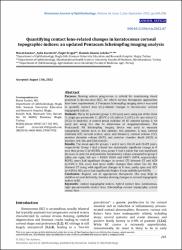Quantifying contact lens-related changes in keratoconus corneal topographic indices: an updated Pentacam Scheimpflug imaging analysis
Citation
Kasıkcı M, Karalezli A, Eroğul Ö, Gobeka HH. Quantifying contact lens-related changes in keratoconus corneal topographic indices: an updated Pentacam Scheimpflug imaging analysis. Rom J Ophthalmol. 2022 Jul-Sep;66(3):245-256. doi: 10.22336/rjo.2022.47. PMID: 36349169; PMCID: PMC9585500.Abstract
Purpose: Slowing ectasia progression is critical for maintaining visual potential in keratoconus (KC), for which various therapeutic approaches have been implemented. A Pentacam Scheimpflug imaging device was used to quantify contact lens (CL)-related changes in keratoconus corneal topographic indices. Methods: Thirty KC patients (group 1; 60 eyes) were using one of the three CL (rigid gas-permeable CL (RGPCL)-10, hybrid CL (HCL)-10, and scleral CL (SCL)-10 patients). A control group included 30 KC patients (group 2; 60 eyes) not using CLs due to intolerance or inappropriateness. The Pentacam® HR Scheimpflug imaging device was used to measure topographic indices such as Km anterior, Km posterior, K max, corneal thickness (CT, corneal central, apex, and thinnest), corneal volume (CV), anterior chamber volume (ACV), and anterior chamber depth (ACD) at baseline, 3rd, 6th, and 12th months. Results: The mean ages for groups 1 and 2 were 32±10 and 31±09 years, respectively. Group 1 had a lower but statistically significant change in K max than group 2 (p<0.038). Also, group 1 had a minor but non-significant decrease in anterior and posterior keratometry values compared to group 2 (pKm ant. right/ left eye = 0.063/ 0.065 and 0.087/ 0.094, respectively). RGPCL users had significant changes in central CT, thinnest CT and ACD (p<0.041). SCL users had more stable changes than other CLs for the thinnest CT along with significant changes in K max, pachy apex and ACV (p<0.036). HCL users had significantly higher K max stability (p<0.039). Conclusion: Regular use of appropriate therapeutic CLs may help to stabilize corneal deformity, thereby slowing changes in corneal topographic indices in KC.


















